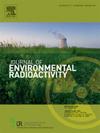高流速条件下 90Sr、137Cs、238U 和 238Pu 在裂缝中迁移的实验室实验和建模。
IF 1.9
3区 环境科学与生态学
Q3 ENVIRONMENTAL SCIENCES
引用次数: 0
摘要
放射性废物处置库周围岩石中存在的裂缝被认为是放射性核素进入公共领域的潜在途径。众所周知,地下水迁移的放射性核素在裂缝中的流动性增强,流速明显快于周围岩石基质孔隙中的流速。本研究的主要目的是调查 90Sr、137Cs、238U 和 238Pu 在裂缝中的迁移率及其在地下水环境中的归宿。同时,还进行了分批和迁移实验,以确定每种放射性核素的吸附系数和迁移参数。结果表明,每种放射性核素的吸附和解吸等温线都可以用 Freundlich 等温线来定量描述。利用吸附和解吸等温线形成的滞后区 "S "来量化四种放射性核素在花岗岩颗粒上的不可逆性,其排序为 238Pu > 137Cs > 90Sr > 238U。四种放射性核素的分布系数(实际 Kd)相差 2-3 个数量级,但 90Sr、137Cs、238U 和 238Pu 在取样孔中的分布趋势和浓度并无显著差异。这些发现表明,要描述花岗岩单一裂缝中放射性核素的迁移过程,必须引入一阶速率常数(αch)并考虑吸附动力学过程。放射性核素在上下花岗岩基体表面的吸附浓度与 "实际 Kd × αch × 时间 "呈正相关,而在水流中的浓度则相反。放射性核素的不可逆性是另一个关键因素。放射性核素的不可逆性越大,其解吸的难度就越大,导致花岗岩基质表面的吸附浓度越高,而水流中的浓度越低。本文章由计算机程序翻译,如有差异,请以英文原文为准。
Laboratory experiments and modeling of the transport of 90Sr, 137Cs, 238U, 238Pu in fractures under high flow velocity
The presence of fractures in the surrounding rocks of a radioactive waste disposal repository is recognized as a potential pathway for radionuclides to enter the public domain. As is well known, radionuclides transported by groundwater exhibit increased mobility in fractures, with flow velocities significantly faster than those in the pore spaces of the surrounding rock matrix. The principal objective of this study is to investigate the mobility of 90Sr, 137Cs, 238U, and 238Pu in fractures and their fate in the groundwater environment. Concurrently, batch and transport experiments were conducted to determine the sorption coefficients and transport parameters of each radionuclide. The results demonstrated that the adsorption and desorption isotherms of each radionuclide could be quantitatively described using the Freundlich isotherm. The hysteresis area "S" formed by the adsorption and desorption isotherm was utilized to quantify the irreversibility of the four radionuclides on granite particles, with a ranking of 238Pu > 137Cs > 90Sr > 238U. The distribution coefficients (real Kd) of the four radionuclides varied by 2-3 orders of magnitude, but the tendencies and concentrations of 90Sr, 137Cs, 238U, and 238Pu in the sampling holes were not significantly different. These findings suggest that it is essential to introduce the first-order rate constant (αch) and consider the kinetic process of adsorption to describe their migration process in granite single fractures. The sorbed concentrations of radionuclides on the surface of the upper and lower granite matrix were positively correlated with "real Kd × αch × time," while their concentrations in water flow were opposite. The irreversibility of radionuclides is another critical factor. The greater the irreversibility of radionuclides, the more challenging it is for them to desorb, resulting in a higher sorbed concentration remaining on the surface of the granite matrix and a smaller concentration in the water flow.
求助全文
通过发布文献求助,成功后即可免费获取论文全文。
去求助
来源期刊

Journal of environmental radioactivity
环境科学-环境科学
CiteScore
4.70
自引率
13.00%
发文量
209
审稿时长
73 days
期刊介绍:
The Journal of Environmental Radioactivity provides a coherent international forum for publication of original research or review papers on any aspect of the occurrence of radioactivity in natural systems.
Relevant subject areas range from applications of environmental radionuclides as mechanistic or timescale tracers of natural processes to assessments of the radioecological or radiological effects of ambient radioactivity. Papers deal with naturally occurring nuclides or with those created and released by man through nuclear weapons manufacture and testing, energy production, fuel-cycle technology, etc. Reports on radioactivity in the oceans, sediments, rivers, lakes, groundwaters, soils, atmosphere and all divisions of the biosphere are welcomed, but these should not simply be of a monitoring nature unless the data are particularly innovative.
 求助内容:
求助内容: 应助结果提醒方式:
应助结果提醒方式:


